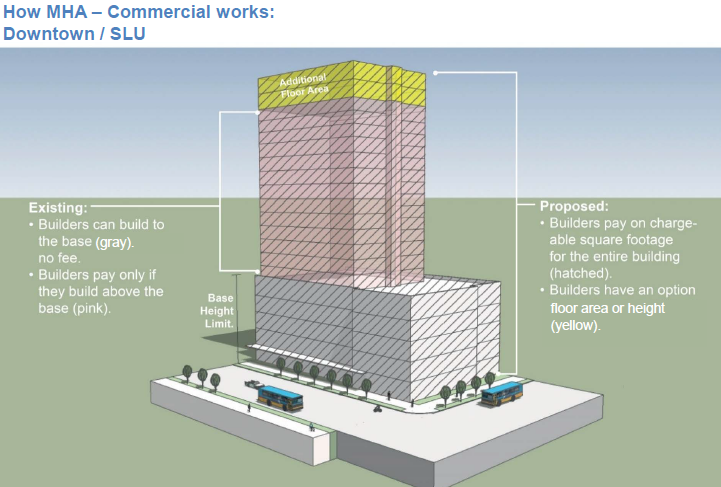
Further amendments to Seattle’s Mandatory Housing Affordability (MHA) program could be on the way. Mayor Ed Murray transmitted a package of changes to bring commercial (MHA-C) requirements in line with Council-adopted policies for residential (MHA-R) this past summer. The two arms of the program were adopted separately with MHA-C first approved in late 2015. The proposed amendments would also make other targeted changes to the overall MHA framework.
Here are the key modifications proposed:
- The MHA-C regulations refer to the measurement of applicable development for affordable housing requirements as “new chargeable floor area” under current code, but would be modified to “gross floor area” to be consistent with other standard Land Use Code language. The method for calculating square footage subject to MHA would also be simpler.
- Under the existing MHA-C ordinance, up to 4,000 square of new chargeable floor area may be exempt from MHA requirements if it meets certain street-level use requirements. This is proposed to be simplified by eliminating language specific to street-level uses.
- Change of use from residential to commercial would be clarified to constitute square footage subject to MHA-C requirements.
- Language exempting commercial square footage from MHA-C when associated with publicly funded low-income housing (households at or below 60% of the area median income) would be modified dropping the amount affordable housing require from 75% to 40% of units and reducing the length of time for participation with rent-restrictions from 50 years to 40 years.
- The lengthy and highly technical program implementation section (SMC 23.58B.010) would largely be removed from the MHA-C chapter. Instead, the language would be housed under Section 1 of the proposed Council Bill and referenced by the revised Land Use Code section.
- New language would be added to the Land Use Code (SMC 23.41.012) that incentive zoning provisions related to MHA are generally not permitted as a departure from code if requested by an applicant.
- Permit requirements for MHA-C would be modified to clarify the process for review and documentation required to approve MHA agreements made by an applicant.
- Tables for the payment and on-site performance requirements would be updated and the language allowing modifications to the requirements (e.g., in the cases of hardship or where development in zone with a height limit greater than 85 feet cannot exceed 85 feet by other regulations) would be greatly revised.
To better mirror the requirements passed under the MHA-R legislation, the Executive is also recommending other policy changes:
- Developers would be required to market affordable housing units to all protected classes.
- Affordable housing units would need to preserved as affordable for 75 years, up from 50 years, and time for units out of service would be tolled extending the affordability period.
- Monthly rent would be clarified to include water, gas, electricity, sewer, garbage collection, recurring fees, and heat in addition to the base rent for the purposes of calculating rent.
- Owner of affordable housing units would have to maintain the dwellings in good condition and carry insurance to replace them in event of disaster.
- Affordable housing units would have to be similar in design to other housing units in terms of size, bedrooms and bathrooms, amenities, access to common areas, and term of lease.
- Affordable housing units created under MHA-C would have to be constructed as new units and the developer would have to enter into an agreement that would be recorded in property deeds.
- Annual certification of compliance with the affordable housing requirements and reporting procedures would be added and be coupled with an annual fee of $150 per affordable housing unit to cover administrative review costs.
- Minor changes will be made to language for affordable housing constructed off-site.The housing would have to be developed as equal or better than if it were developed on the same site and the housing would have to be located within the same urban village or center, or within a quarter-mile of the site if located outside of the urban village or center. A separate agreement would have to be executed if the MHA-C housing would be owned by another property owner off-site to ensure that the units would be developed in accordance with the specific MHA-C requirements of the development permits. The developer would also be required to produce evidence that sufficient credit would cover the costs of construction of off-site affordable housing units in that the developer does not have occupiable affordable housing units prior to occupancy of the primary development and any other associated penalties.
The City Council’s Planning, Land Use, and Zoning Committee will take up discussion on this today at its 9:30am meeting, which is streamed on the Seattle Channel as always.
UPDATE 12/21/2016: This legislation was adopted.
Stephen is a professional urban planner in Puget Sound with a passion for sustainable, livable, and diverse cities. He is especially interested in how policies, regulations, and programs can promote positive outcomes for communities. With stints in great cities like Bellingham and Cork, Stephen currently lives in Seattle. He primarily covers land use and transportation issues and has been with The Urbanist since 2014.


